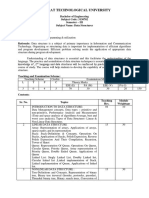0% found this document useful (0 votes)
28 views11 pagesQuestions
The document outlines a syllabus for a course on data structures, covering fundamental concepts such as arrays, linked lists, stacks, queues, searching, sorting, binary trees, and graphs. Each unit includes essay and short answer questions designed to assess understanding of the material. The syllabus emphasizes algorithm analysis, data structure types, and their applications.
Uploaded by
Nallamilli Naga SreyaCopyright
© © All Rights Reserved
We take content rights seriously. If you suspect this is your content, claim it here.
Available Formats
Download as PDF, TXT or read online on Scribd
0% found this document useful (0 votes)
28 views11 pagesQuestions
The document outlines a syllabus for a course on data structures, covering fundamental concepts such as arrays, linked lists, stacks, queues, searching, sorting, binary trees, and graphs. Each unit includes essay and short answer questions designed to assess understanding of the material. The syllabus emphasizes algorithm analysis, data structure types, and their applications.
Uploaded by
Nallamilli Naga SreyaCopyright
© © All Rights Reserved
We take content rights seriously. If you suspect this is your content, claim it here.
Available Formats
Download as PDF, TXT or read online on Scribd
/ 11


































































































